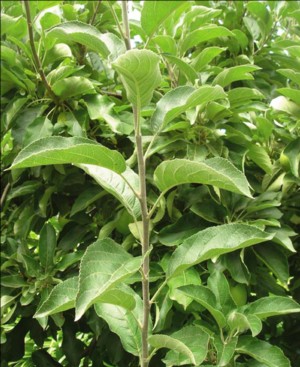Prune fruit trees while the weather is still warm to encourage better fruiting
by Janie Varkulevicius
Pruning at the end of summer can encourage flowering and fruiting wood and also help keep your trees to a manageable size. Dragging yourself into the garden on a cold wintry day is fine just to check the general structure of your trees, or to re-invigorate old trees, but now is the time to attend to the fine details. Not only is pruning with the sun on your back a great gardening joy but it also encourages fruiting wood. After the flush of growth, apples, pears, nectarines and apricots are looking a bit shaggy with long wands of growth heading skywards. It’s like there is a competition for which stem can be the tallest or longest. In fact, the competition is fierce. Each stem wants to outgrow its neighbour so it can bask in the sun rather than sulk in the shade. All plants need light, but flowering/fruiting wood on fruit trees needs it especially.
Apples, pears and, to certain extent, apricots flower and fruit on short warty growths called spurs. It makes sense to encourage this growth. Notice how short and stumpy they are? They are the complete opposite of that long, slender spring growth. So grab your sharpest secateurs and cut down that long growth to just one or two new-season buds. Note it’s best to cut to an outward- and downward-facing bud to keep the centre of the tree open and the fruiting growth within reach.
This diverts the plant’s energy to feed just those two buds rather than a long, leafy stem. As a result, these buds get fat and fruitful within two seasons. Note the fat bud that has developed after last year’s summer pruning? It will fruit next season. The picture of the apple spurs shows last year’s summer pruning scar that encouraged this fat and fruitful spur wood. Nectarines and peaches flower and fruit on growth that was produced last season (never on old growth), but pruning now is just as effective for them as it is for apples, pears and apricots. These fabulous fruit trees live fast and die young. If they are not pruned they tend to turn into a large, bloated umbrella shape with a few fruit scattered way out of reach on top of a mass of foliage. To curb this exuberant and unfruitful behaviour, pruning is the answer.
Nectarines and peaches are produced from fat buds arranged either side of a slender leaf or wood bud. This triple bud (if well pollinated) produces two fruits and the leaf bud extends to form next year’s triple buds that will flower and fruit. This long, soft growth can be shortened back to a triple bud, thus keeping the fruiting wood closer to the main branches. If it’s not dealt with firmly, this soft spring growth will grow thin and floppy and eventually die off. Always be aware that fruitful growth demands the sun, so cut back the growth at the top of the tree more than that on the lower branches. Good fruit needs sun, so make sure all branches on the tree have good access to light.
Not only does this pruning encourage and strengthen fruiting buds, it also makes your tree much easier to net — no lanky growth to snag your net and far fewer harsh words between those doing the netting! What was that about controlling tree size? All well-grown plants have the same number of roots as they do shoots. In other words, what you see above the ground is equal to the roots below ground. If you reduce the size of your tree by pruning now, the root system will shrink to match. In summer, the tree will not have another spurt of growth like the spring flush, so the above- and below-ground parts of the plant come into balance.
If you leave all that long wood until the winter, the dormant root system will behuge. When the tree is winter pruned, the root system will try to replace the lost growth with an enormous burst of spring growth. This growth is generally leafy and woody — not fruiting wood. This can be a good idea if you need to invigorate a tree, but more of this when winter comes. So get out into the garden while the sun still shines and ensure the best fruiting wood on your trees.







